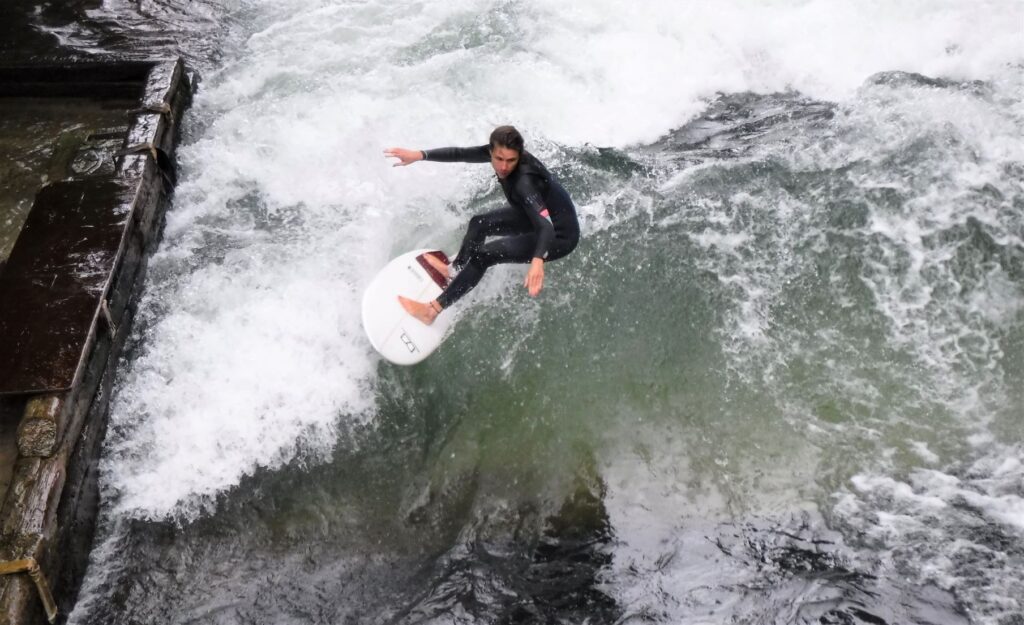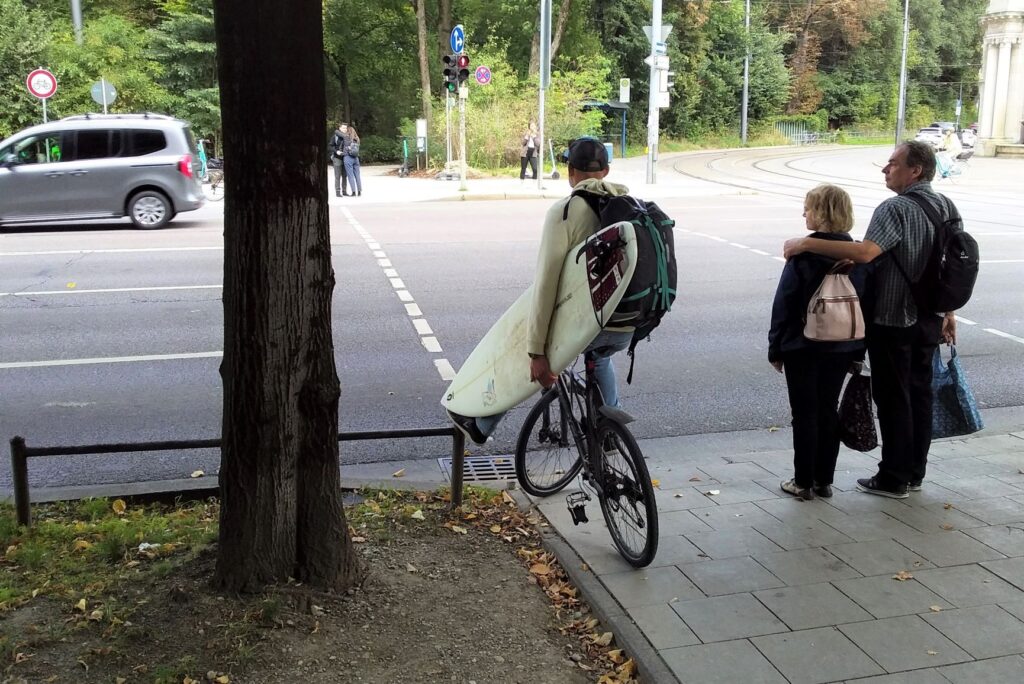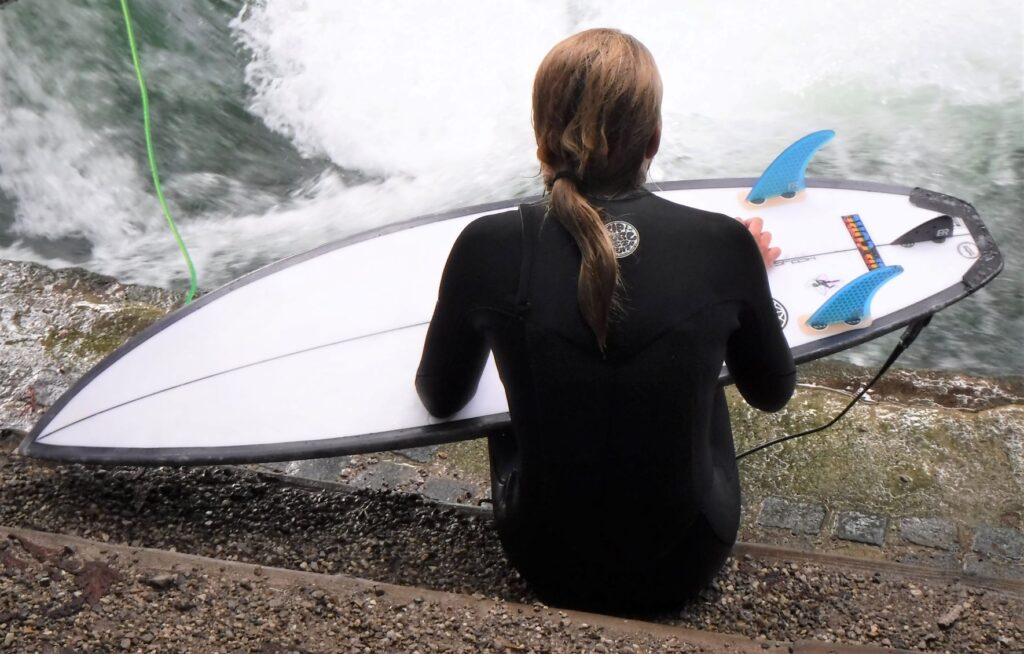Munich Five-O

The city of Munich is known for many things, like BMW, Bayern Munich FC, and of course the annual Oktoberfest. It is also acknowledged as the centre of German, if not European, river surfing. Needless to say I was keen to check it out, so headed to the Englischer Garten on an overcast Autumn day to see what it was all about.
Munich is a long way from the beach, and even further from a beach with rideable waves. The first time you see someone carrying a surfboard through the centre of town it’s an odd sight to say the least. So is the first time you see a bloke wearing knee-length, embroidered suede leather shorts. However in Munich, both river surfing and lederhosen have a long history.

Munich boasts several river waves, with the premier spot being the Eisbach. The Eisbach River is a 2km, human-made tributary of Munich’s Isar River, which appears from under the Eisbach Bridge and flows through the picturesque Englischer Park. The water runs faster than forty bastards*, and when the engineers dumped some concrete blocks into the water just beyond the bridge to try to control the current, they inadvertently turned Munich into a surfing location overnight. The first surfers rode the wave in 1972 (the history of liederhosen is a little longer, but let’s stick with river surfing for now).
After crossing the busy Prinzregentenstrasse, I peered over the bridge, and got my first look at the wave. It’s…well…not great. It’s small with a messy face of lumps and bumps. But hey, if your local beach only offered this wave, you’d still get out amongst it, and Munich surfers are keen to say the least.
I was suprised to see how many people had gathered to watch the locals surf. I knew it would be an interesting curiosity to a few tourists, but the bridge and banks were full of spectators.
This kid completely lost his shit with every ride.
There were surfers lined up on both banks, and one in the water. I watched for a bit and soon worked out the protocol. Considering the creek is only about 12 metres wide, with concrete on one side and a timber wall on the other, commense sense dictates that only one surfer can be in the water at any one time. When this surfer falls and is whisked away downstream at an alarming rate, a surfer from one bank enters the water. When this surfer is swept away, another from the opposite banks enters.
With surfers queuing up to get amongst it, the action in the water comes thick and fast.
I had read that if one surfer spends too long on a single ride, as the wave is endless after all, then those waiting will slap their open palms on their boards to signal ‘time’. I never saw this done, as most wiped-out before those in the queue got impatient. The only board slapping was done in appreciation of a good manoeuvre.
There was a variety of styles of take off on display, which could be grouped into ‘paddle in’, ‘step off’, standing jump’, and ‘running jump’. The ‘paddle in’ looked like the most difficult option, and I only saw one successful attempt while I was there.
‘Step off’ was the most gentle take off technique, ‘standing jump’ was impressive, and ‘running jump’ was speccy and really gave you some speed down the line.
Fish were the board of choice for most surfers, with either square or swallow tails. Most were using a twin fin set-up having removed the centre fin, or replaced it with a small one.

I also noticed that many of the surfers were wearing earplugs. You sometimes see this at cold water surf spots, as prolonged exposure to icy water and wind can cause ‘surfer’s ear’ (a bony growth that forms in the ear and can cause hearing impairment). However I think the Eisbach surfers were wearing them as runoff from city streets can be pretty nasty, and needless to say it’s better to restrict the amount of bacteria, chemicals or heavy metals getting in your Germaine Greers. Eisbach translates as ‘ice stream’, and apparently stays cold year-round, so despite being a mild, early-Autumn day nearly everyone was wearing full length wetsuits.
There are two ways of exiting the Eisbach standing wave, either out of control…
…or in control, like Mr Smooth here…
Wipeouts lead to a fast ejection out the back of the wave, and an even faster trip downstream. The creek channel has both a shallow side and a deeper one, with the deep water side really moving. Surfers would stroke out for the bank, pick their spot, and heave themselves out of the water. Meanwhile their boards would bump against the concrete wall until they were retrieved.
A wipeout on the slow side of the channel made for a much more straightforward and less fibreglass-crunching exit.
At the Eisbach there was a wide variety of skill levels on display, from beginners to stylish, advanced surfers who looked like they had some ocean experience. Regardless, it seemed like everyone was having a great time, including all of us on the bank enjoying the unique spectacle of surfers riding a wave in downtown Munich.
Find out more about the Eisbach River surfing here
If you liked this post, you may also enjoy Surfing The Med
*Australian slang: very quickly
Leave a Reply